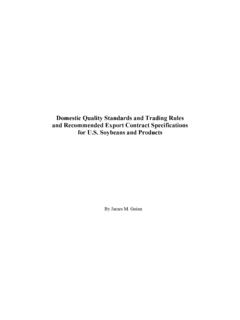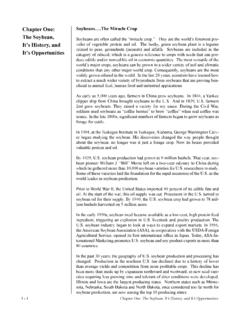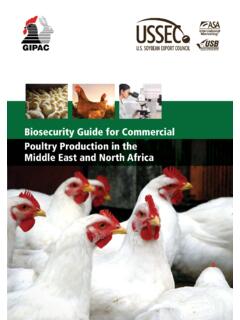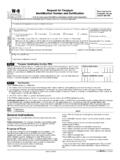Transcription of Chapter Two: Dependable Quality - U.S. Soybean Export Council
1 Chapter Two: Quality Standards for Soybeans and Soy Products2- Chapter Two: Quality Standards for Soybeans and Soy ProductsDependable QualityOne of the reasons for the dominant position of the United States in the world Soybean market is the dependability and efficiency of the domestic and Export markets. This is due, in part, to the marketing system s clear Quality standards, which are governed by both contract specifications and a government-regulated system of guidelines that control the Export inspection, sampling, grading and weighing of grain and oilseeds. The Federal Grain Inspection Service (FGIS) oversee these standards and inspection procedures. FGIS is a division of the Department of Agriculture s (USDA) Grain Inspection, Packers and Stockyards Administration (GIPSA). FGIS establishes the Official Standards for Grain, which are used each and every day by sellers and buyers to communicate the type and Quality of grain bought and principal functions of FGIS are: Establish and maintain official standards for grain and oilseeds.
2 Inspect and weigh grain and oilseeds for Export and domestic commerce. Establish standard testing methods and procedures and approve equipment used in such inspection and weighing. Create a national inspection and weighing system that applies grading and weighing procedures in a uniform, accurate and impartial manner. Monitor grain handling practices to prevent fraud, deception and intentional degradation of grain Quality by illegal introduction of foreign material or other non-grain material. Throughout its history, FGIS has performed these functions remarkably well, and it has earned a well-deserved worldwide reputation while doing so. The existence of the system of official grading standards and an independent, impartial agency to perform the inspection and weighing functions are a distinct advantage for soybeans over other Standards for SoybeansThe Grain Standards Act requires specific standards to identify and measure the important physical characteristics and Quality factors for most grains and oilseeds.
3 The grades, classes and conditions reported on official certificates are determined according to the factors defined in these standards. A grade certificate for each lot or shipment is issued with other conditions, such as insect infestation and noxious odors, noted. There are three classes of measurements in the system of grades: grade determining factors, non-grade standards, and informational criteria. Current grading standards list six grade-determining factors for yellow soybeans. These are test weight (bulk density), splits, total damaged soybeans, heat damaged, foreign material and soybeans of other colors. Moisture is a non-grade standard and is determined on each lot with the results appearing on all official inspection certificates. Oil and protein analysis is informational criteria and will be performed upon request. Soy: International Buyers Guide2-2 Grade determining factors use maximum or minimum limits to assign a numerical grade to a sample.
4 The specific grade standards for soybeans are contained in the following table: Soybean Grade and Grade RequirementsGrading FactorsGrades limits ofTest weight kernels: Heat (part of total) of other colors 1 count limits of:Other materials Animal waste9999 Castor Beans1111 Crotalaria seeds2222 Glass0000 Stones 2/3333 Unknown foreign substance3333 Total 3 Sample grade soybeans that: Do not meet the requirements for Nos. 1, 2, 3, 4; or Have a musty, sour, or commercially objectionable foreign odor (except garlic odor); or Are heating or of distinctly low Quality . / Disregard for Mixed soybeans. 2/ In addition to the maximum count limit, stones must exceed 0. percent of the sample weight. 3/ Includes any combination of animal filth, castor beans, crotalaria seeds, glass, stone, and unknown foreign substances. The weight of stones not applicable for total other of the most significant factors in grade requirements is foreign material (FM).
5 Foreign material is defined as all material that readily passes through an 8/64 inch ( mm), round-hole, perforated sieve and any material other than soybeans remaining atop the sieve. The limitation in #2 soybeans is two percent. FM levels at the first point of sale in the are commonly one percent, however, each handling of the Soybean lot can generate more FM because of breakage of the Soybean seeds, especially when the moisture content is low. The presence of foreign material in soybeans adversely affect storability and drying/aeration efficiency, and, unless removed prior to processing, will affect the Quality of both the oil and the protein meal. A second significant factor in grade requirements is damaged kernels, specifically heat damage. Damaged kernels have an effect on oil Quality such as higher acid values, higher peroxide values, higher non-hydratable phosphatides, off color and reduced shelf life.
6 FGIS defines damaged kernels as soybeans and pieces of soybeans that are badly ground-damaged, badly weather-damaged, diseased, frost-damaged, germ-damaged, heat-damaged, insect-bored, mold-damaged, sprout-damaged, stinkbug-stung, or otherwise materially damaged. Stinkbug-stung kernels are considered damaged kernels at the rate of one-fourth of the actual percentage of the stung Two: Quality Standards for Soybeans and Soy Products2- Test weight is a measure of weight per unit volume and expressed in pounds per volume bushel. There is no correlation of test weight to Quality factors such as protein and oil and is only useful for determining the relationship between weight and volume when calculating storage space or processing are broken soybeans, with one-quarter or more of the seed missing, generally half-pieces, but otherwise undamaged. A 10/64-inch by -inch ( mm by mm) slotted screen is used to separate splits for grade determination.
7 Splits can impact oil are two classes of soybeans, yellow soybeans and mixed soybeans. Yellow soybeans have a yellow or green seed coat and are yellow in a cross section. They may not contain more than 10 percent of seeds of other colors. Mixed soybeans are any that do not meet the standard for yellow soybeans. Moisture content is not part of the grade determining factors but is mandatory information in official inspections. Proper moisture specification and storage management are the keys to successful long-term storage of soybeans. Dependent on end use and ambient storage condition, there is a range of recommended moisture contents considered safe for storage. For direct food use, or for use as seed, moisture at or below 11% is recommended. For solvent extraction, moisture is suggested if processed within a year. Average moisture beyond 13%, widely divergent moisture lots, or storage conditions that lead to moisture migration and accumulation can often result in serious Quality deterioration in a relatively short time span.
8 In most years, exports of soybeans contain moisture well below 13%. Protein and oil content are not part of the Grades but is an important informational factor in Quality standards. FGIS will perform an analysis of protein and oil upon request. This analysis is recommended as it provides significant information to determine value or end use preference. Results are reported to the nearest tenth percent on a standard 13% moisture basis or other moisture basis, if desired. The long-term average for soybeans produced in the is 35% protein and 19% oil on a 13% moisture basis. Soybean protein can be as low as 25% and as high as 50%, although a range of 30% to 40% is common in commodity-type soybeans. Oil content can range from 13% to 25%, with a commodity-range of 16% to 23%. Grades and Quality determination are conducted by FGIS personnel or by other independent inspectors and agencies specifically trained and authorized by FGIS.
9 The inspections follow specified standard procedures. This process assures foreign and domestic buyers that the Quality of the soybeans they receive is what they expected as determined by an independent inspection conducted by trained and unbiased standards do not change by the season or the year or due to a Quality problem that may be prevalent in a certain year. They can be and are changed when market practices or commercial realities clearly make the old standards out of date. government requirements call for a cautious and deliberate rule-making process that relies heavily on public comment and debate. Such changes are infrequent and usually more than a year is required to make changes to grade standards. This provides the interested public notice and time for input before any change in grading standards is officially Soy: International Buyers Guide2-4If an importer of soybeans believes there is a discrepancy between the grade determined at loading and the Quality received at discharge, the importer can file a complaint with the agricultural counselor or attach at the Embassy or with the Agricultural Trade Office if there is not an agricultural office at that Embassy.
10 The Embassy forwards the complaint to FAS in Washington, , who submits the complaint to FGIS. Since FGIS keeps file samples from every Export shipment for 90 days, the chances are good that the points of the complaint can be compared with that sample. Sometimes, the receiver of the cargo draws a sample at discharge and submits it along with the complaint. If so, it is also examined by FGIS personnel. After collecting all available information, FGIS sends the information and its response back to the Embassy to be passed on to the complainant. FGIS is not empowered to change its original grade certificate, nor will it place itself between buyer and seller as an and Inspection ProceduresFGIS is also responsible for the system of weighing grain and soybeans to determine and officially certify exactly the quantity that has been loaded and shipped. Official weighing under FGIS supervision is mandatory for all Export shipments of soybeans and grains.








